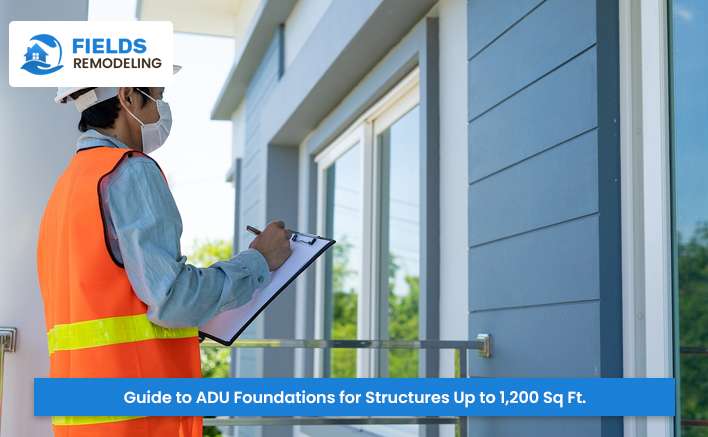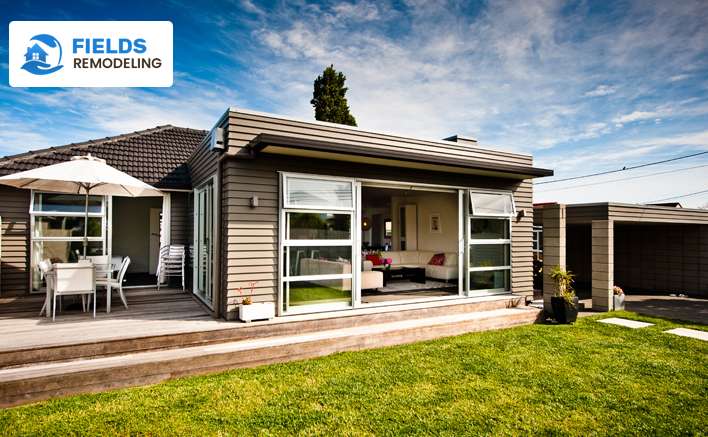ADUs or additional dwelling units are a growing trend. They are small homes that are built on the same property along with the main house. The first step to building an ADU is to lay a strong foundation. The foundation is the backbone of the ADU. It supports the entire building. A good foundation makes the ADU durable for a long time. It also protects against weather and natural disasters.

The slab foundation is the simplest type of foundation. It is a thick concrete sheet. It is poured directly on the ground. Slab foundations are less expensive and faster to build. It works best on flat ground. Slab foundation is suitable for areas with warm climate. There is less risk of ice formation here.
Crawl space foundation has a space between the floor and the ground. This space is suitable for crawling. Crawl space protects from moisture. It helps in hiding pipes and wires. Crawl space foundation is good in cold areas. It protects the building from ground moisture.
The basement foundation forms a complete room. It is below the ground. The basement provides additional space. It can be used for storage or living. Basement foundation is expensive. But it is very strong. It is best in cold areas.
Concrete is the most common material. It is strong and durable. Concrete protects against water and insects. It also provides protection against fire. Concrete is easy to mold. It can be made in any shape. Concrete lasts a long time. Concrete is a mixture of cement, gravel, and water. Sometimes special additives are also added to it. These additives make concrete stronger. It is very important to get the concrete mix right.
Block foundation is made of concrete or clay blocks. These blocks are placed on top of each other. Block foundation is easy to build. It is also less expensive. Block foundation provides good insulation. It protects against cold and heat. Mortar is used in block foundation. This mortar joins the blocks. Sometimes steel bars are also inserted in the block foundation. These bars make the foundation stronger. Block foundation is often plastered. This plaster makes the foundation beautiful and strong.
Stone foundation is a very old method. It is very strong. Stone foundation can last for centuries. It also looks beautiful. But it is difficult to build a stone foundation. It also takes more time. Big stones are used in stone foundation. It is very important to set these stones properly. Small stones are filled between the stones. This makes the foundation stronger. Cement or lime mortar is applied in stone foundation. This mortar joins the stones.
Examine the site thoroughly. Get the soil tested. Check the water flow. Pay attention to the roots of trees. All these can affect the foundation. Also keep in mind the slope of the site. This will determine the flow of water. The strength of the soil is checked in the soil test. Weak soil requires a special foundation. The water level is also checked. Special waterproofing is necessary in places with high water. Find out the electricity and water lines on the site. Excavation will have to be done by avoiding them.
Dig to the correct depth. The size of the excavation will depend on the type of foundation. Observe the condition of the soil during excavation. Pay attention if there is any rock or water source. After digging, level the ground well. Make a correct map of the foundation before digging. Dig according to this map. Take care of safety during excavation. Protect the walls from falling in deep digging. Put the excavated soil at the right place. This soil can be used for filling later. After digging, clean the foundation site. No garbage or stones should remain.
Formwork is the blueprint of the foundation. It gives the correct shape to the concrete. The formwork should be strong. It should be able to bear the weight of the concrete. Set the formwork correctly. This will keep the shape of the foundation correct. Use good quality wood or steel for formwork. Join the formwork well so that the concrete does not leak. Apply oil or release agent on the formwork. This will make the formwork easy to remove after the concrete dries. Make holes in the formwork at the right place. These holes will be for pipes and wires. Check the formwork by leveling it. Make sure the formwork is absolutely straight.
Steel bars give strength to the foundation. Place the bars at the right distance. Fasten them properly. The quality of steel should be good. Do not use rusted bars. Do the steel work carefully. The size and number of steel bars depends on the design of the foundation. It is important to bend the bars properly. Do not break the bars while bending. Use special wire to join the bars. Use cover blocks while making the steel mesh. These blocks keep the steel at the correct depth in the concrete. Get the steel work checked by an engineer. This will ensure that everything is correct.
Mix the concrete in the correct proportion. Pour it all at once. There should be no air bubbles while pouring the concrete. Vibrate the concrete well. This will spread it everywhere. After pouring the concrete, let it dry properly. Know the weather before pouring the concrete. Pouring concrete in extreme heat or cold can be difficult. Keep running the mixer continuously while pouring the concrete. This will prevent the concrete from setting. Pour the concrete at a uniform height. Keep leveling the concrete in between. After pouring the concrete, keep watering it. This will make the concrete dry slowly and strengthen it.
Curing makes the concrete strong. In this, the concrete is kept moist. Curing should be done for at least 7 days. During this time, keep sprinkling water on the concrete. Curing will prevent cracks in the concrete. Cover the concrete with a plastic sheet for curing. It maintains moisture. Curing is more important in hot weather. During this time, pour water on the concrete several times a day. Do not put any weight on the concrete during curing. This can weaken the concrete. After curing, let the concrete dry slowly. Sudden drying can cause cracks in the concrete.
Waterproofing protects the foundation from water. Use a special coating for this. Apply the coating on the outside of the foundation. Pay attention to all joints and corners. Let the waterproofing dry thoroughly. There are many types of products available for waterproofing. Liquid membrane, sheet membrane, or bentonite clay can be used. Be careful about the weather while waterproofing. Do not waterproof in the rain. Place a protection board over the waterproofing. This will protect the waterproofing from damage. Make good arrangements for drainage after waterproofing. This will keep water away from the foundation.
Insulation saves energy. It protects against cold and heat. Place insulation on the inside of the foundation. Use foam board or fiberglass. Fit the insulation properly. Look at the R-value of the insulation. It tells the capacity of the insulation. Choose the appropriate R-value for your area. Use a vapor barrier while installing insulation. It prevents moisture. Do not leave any gaps in the insulation. Gaps can let in heat or cold. Cover the insulation with fire-rated material. This is important for safety.
A good drainage system is important. It moves water away from the foundation. Install drain pipes. Lay them with a slope. Lay pebbles around the pipes. This will help the water flow faster. Drainage pipes should have holes. These holes allow water to flow in. Wrap the pipes with filter cloth. This prevents soil from getting into the pipes. The outlet of the drainage system should be in the right place. It should release water in a safe place. Clean the drainage system regularly. This will make it work well for a long time.

Follow local building codes. These rules ensure safety. Know the rules for foundation depth and thickness. Know the standards for material quality. Work according to building codes. Building codes keep changing from time to time. Stay up to date with the latest codes. The code may have special rules for ADUs. Read these rules carefully. Not following the building code can result in a fine. Or the already built structure may have to be demolished. If you do not understand the code, seek expert help.
Get the necessary permits. Do not work without a permit. Apply for a permit. Submit the necessary documents. Start work only after getting the permit. There can be a fine for not getting a permit. Getting a permit can take time. Plan ahead for this. You may have to pay a fee for the permit. Include this expense in your budget. After getting the permit, keep it safe. You may have to show the permit at the time of inspection. Some permits come with a time limit. Keep this time limit in mind.
Get regular inspections done. This ensures safety. Call for inspection on time. Follow the inspector’s suggestions. Correct any deficiency immediately. Proceed only after passing all inspections. Keep everything ready for inspection. Keep the necessary documents and maps with you. Answer the inspector’s questions correctly. If you do not understand anything, ask. Read the inspection report carefully. Follow the advice it gives. Sometimes there is more than one inspection. Be prepared for each inspection.
Building an ADU foundation is an important job. It is the foundation of the entire building. A good foundation makes the ADU strong and durable. Choose the right materials when building the foundation. Follow the construction process carefully. Pay attention to safety regulations and legal requirements. Well-done waterproofing and insulation will pay off in the long run. Regular maintenance will keep the foundation in good condition for a long time. A strong foundation will make your ADU safe and comfortable. It will also protect your investment. With a good foundation, you will be able to enjoy your ADU for a long time.
It is very important in earthquake-prone areas. Earthquake-resistant design uses special joints and strong materials. This design keeps the ADU safe during earthquakes. Local building regulations may require it.
Radon is a dangerous gas that comes from the ground. Special membranes or sealants are used to protect against it. A ventilation system can be installed in the foundation. This system removes radon gas. Regular radon testing is also necessary.
Yes, it is possible to add a water harvesting system to an ADU foundation. Changes may be required in the foundation design for this. Space will have to be left for a tank or cistern. Piping will have to be arranged. This system helps in saving water.
Wiring and sensors for a smart home can be installed in the foundation itself. Cables can be laid for temperature control, security systems, and energy management. Provision can be made for Wi-Fi extenders or mesh networks in the foundation.